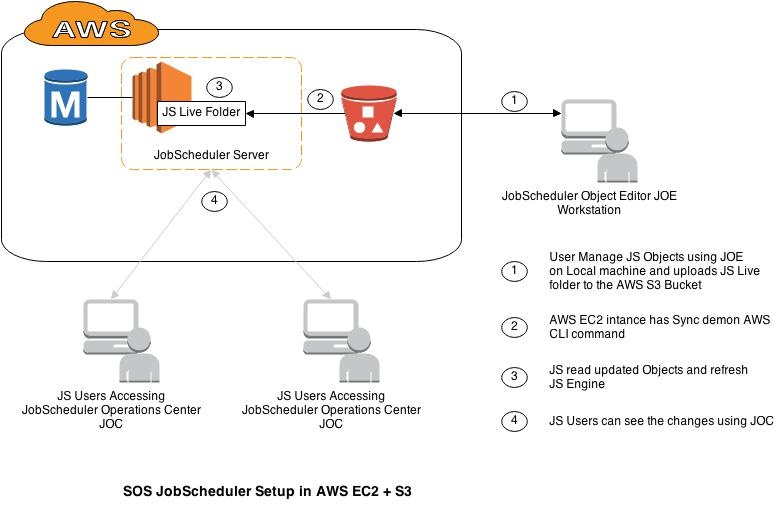| Table of Contents | ||||||||||
|---|---|---|---|---|---|---|---|---|---|---|
|
General
Since The trend of towards hosting enterprise applications i.e. Datawarehouse such as Datawarehouses, Databases, BatchApplications into Cloud i.e. , Batch Applications, etc. in Clouds such as the Amazon AWS EC2 Instance is growing and JobScheduler is no exception. Recent time Recently we have had many customer queries regarding settings setting up JobScheduler in the Cloud.
JobScheduler can be setup as a single instance, as primary and backup instance instances or many JobScheduler instances together can be setup as JobScheduler cluster in a Cloud infrastructure.
System setup
JobScheduler can be installed in a Cloud Instance ( Amazon AWS EC2 Instance) with the usual JobScheduler installer i.e. command line/GUI as per as a conventional OS.
Once JobScheduler is has been installed and configured JobScheduler objects can be deployed to the Cloud JobScheduler instance as well.
One of the interesting way ways to deploy JobScheduler object objects directly to Amazon AWS EC2 instance is to put the JobScheduler objects i.e. jobjobs, jobchain jobchains, order orders etc into AWS an S3 Bucket and SYNC the S3 Bucket to the JobScheduler Serverlive folder.
1. User can manage JobScheduler Objects
User or group responsible to Manage manage JobScheduler objects i.e. create/update Job/JobChain/Order etc can create XMLs using JOE -i on there (JobScheduler Object Editor) on their Desktops.
2. User
...
uploads JobScheduler objects into AWS S3 Bucket
Once Objects are created, user can upload them using AWS S3's browser utility or any other widely available desktop AWS S3 sync utility.
There are many solutions available to mount AWS S3 as desktop drive or as local file system. User can choose any widely available tool as per as there their requirement.
3. AWS CLI Sync command download(Sync) JobScheduler Object from S3 Bucket to local Live folder
User can create simple demon script started with system startup on JobScheduler server and sync AWS S3 Bucket to local live folder.
To keep JobScheduler Objects for different development phases user can create different Buckets i.e. JobScheduler-DEV, JobScheduler-TST, JobScheduler-INT JobScheduler-PRD.
To deploy JobScheduler Object Objects from their respective Buckets User , users can map DEV Bucket with DEV server and so on. One can use AWS IAM and Security groups to manage Rights on S3 Buckets and correct mapping with servers.
So, if someone try tries to sync DEV JS objects on Prod server, AWS security group will prevent such action.
...
Example: simple AWS CLI sync command
| Code Block | ||
|---|---|---|
| ||
test@js-eudebe-001:~> aws s3 sync s3://jobscheduler/jobscheduler-dev /app/jobscheduler/config/live
|
Please see more options here AWS CLI sync command documentation
4. JobScheduler reads changed/updated objects and refresh the JobScheduler engine
JobScheduler continuously monitor monitors the Live folder for any change. As soon as JobScheduler found finds any changes in the objects i.e. Job/Jobchain/Order, JobScheduler update updates the JobScheduler engine with changes i.e. Calendar, executable or any other condition. Changes are immiedialty immateriality visible in the JOC -I(JobScheduler Operations Center) and JID -I(JobScheduler Information Dashboard).
5. JobScheduler users can see the the updated objects in JOC
6. Drawio XML file
- Drawio File: [ Drawio-JS-AWS-EC2-S3-Concept.xml | http://www.sos-berlin.com/download/samples/Drawio-JS-AWS-EC2-S3-Concept.xml]
